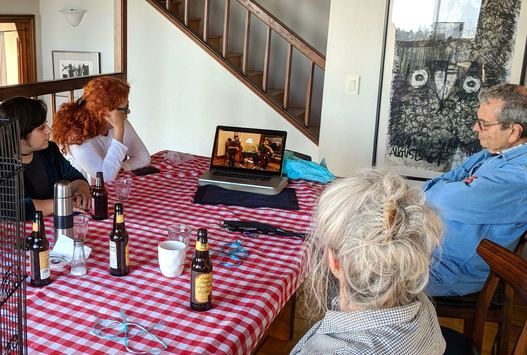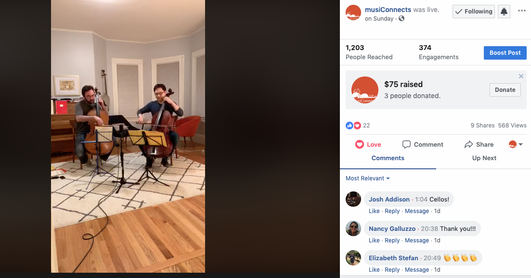|
In 2017, thinking creatively about how to help musiConnects (which serves a specific geographic community) reach a much broader audience of potential supporters, I proposed a series of live-streamed mini-concerts. Since each of musiConnects' Resident Musicians represents a social network that only partially intersects with the organization's audience base, my hypothesis was that sharing a brief taste of each musician's individual artistry, tied to the musiConnects mission, would introduce potential new supporters to our work, even if they were never able to attend a concert in the flesh. Because of the organization's focus on Mattapan, a neighborhood well off the beaten track for Boston's classical music aficionados, we position the Resident Musicians' live performances as the vehicle to reach across geographic and cultural barriers. Typically, this happens through performances in living rooms, libraries, and other community venues that are not concert halls. These activities require the availability of all members of an ensemble and plenty of logistical coordination. As the tenth season was winding down, and the staff was running low on energy, I was seeking to find a way to share musiConnects more widely but without additional hassle. The result? A series of live-streamed musical events. Each would be performed by one of the nine Resident Musicians from the comfort of his or her own home (or the musiConnects office). It was easy. It was fun. It was successful enough in reaching new supporters that we have continued to do it in 2018 and 2019, possibly building a tradition. And it has made me think more about the potential of performing arts organizations using live-streaming as a relationship-building tool. Along with silly and informal promotional videos, I've seen plenty of 20-second snippets of rehearsals begin to show up in communications from organizations. I've also enjoyed seeing musicians being vulnerable enough to share outtakes and behind-the-scenes moments on social media. (Perhaps the Miro Quartet enjoys having a laugh at their own expense--and posting it--more than most?) It's clear that live-streaming is increasingly relevant to the entirety of the performing arts ecosystem. But is it happening in ways that address how differently the iPhone generation consumes live performance? The NightCaps Series is only one way to begin to explore this opportunity, and I'm looking forward to further and more rigorous experimentation. Relatedly, to understand where we may be headed, it's worth reading this story in The New Yorker about a teen drama designed to unfold across time on social media platforms--rather than on TV. Here I am in May 2017, performing Bach in the direction of an iPhone taped to a music stand. Even though I'm not one of the Resident Musicians (I'm a board member), I wanted to put my money where my mouth was since I had proposed the idea. musiConnects' Resident Musicians get the credit for coming up with the concept of pairing a favorite nightcap with each performance, leading to naming this the "NightCap Streaming Series." Each performance is casual, low tech, and intimate. There is a low pressure request for support (through the link provided on the organization's FaceBook page), but a donation is not a barrier for enjoying the free online performance. Ideally, the fundraising component serves largely to encourage participation, and the dollar goal reflects this. For instance, a recent NightCap Streaming Series fundraising goal was $750 to purchase music stands for students, and we accomplished that goal with ease. Resident Musicians broadcasting their performance from the musiConnects studio in Roslindale, MA. June 17, 2018, 9 pm EST: playing duets in my living room with Jacques Lee Wood, Resident Musician. June 17, 2018, 6 pm PST: Family friends watching our performance at the dinner table in Berkeley, CA. March 31, 2019: Reprise of cello duets, this time in Jacques' living room.
0 Comments
Your comment will be posted after it is approved.
Leave a Reply. |
AboutSharing student project documentation and, more recently, my own. Archives
June 2022
Categories |






 RSS Feed
RSS Feed
